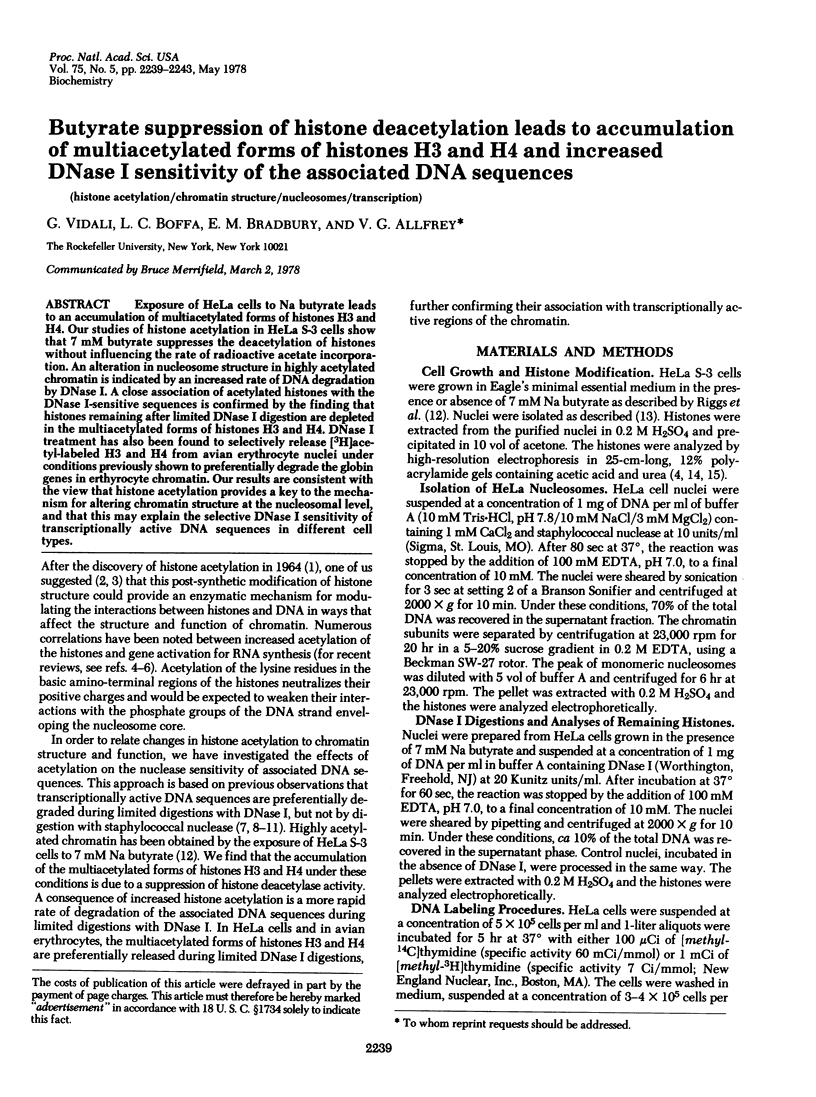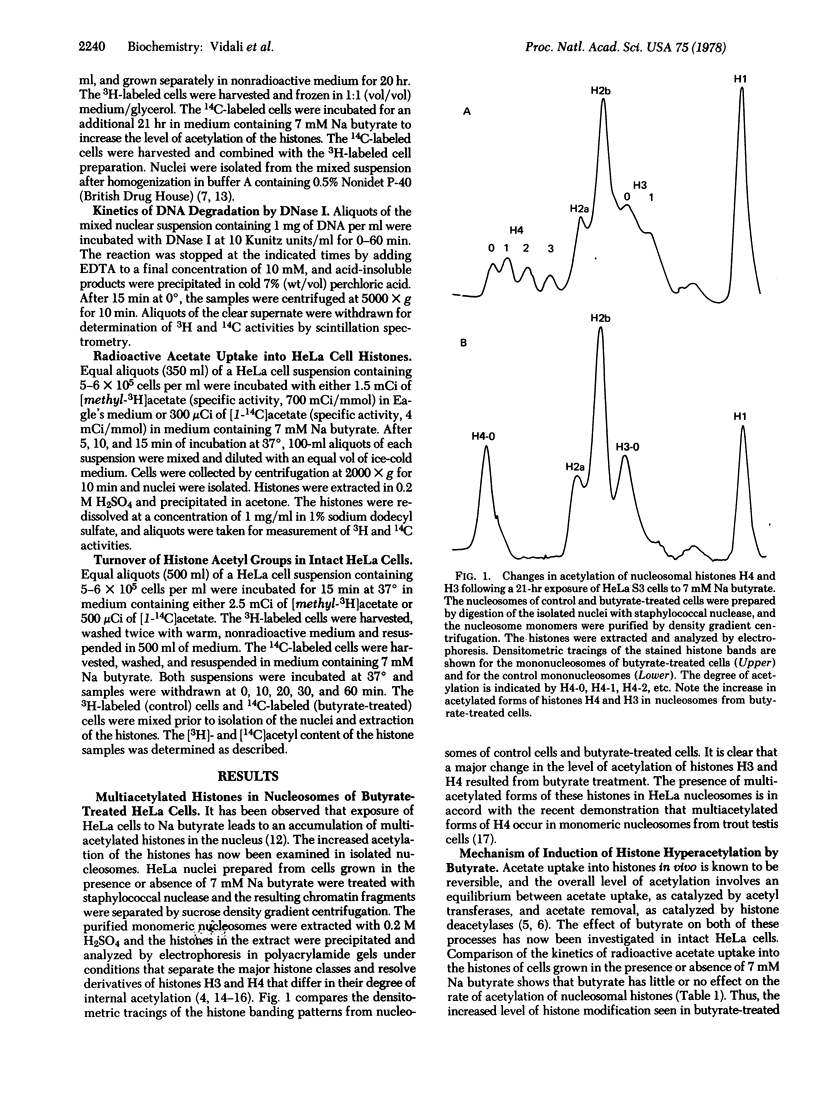Abstract
Exposure of HeLa cells to Na butyrate leads to an accumulation of multiacetylated forms of histones H3 and H4. Our studies of histone acetylation in HeLa S-3 cells show that 7 mM butyrate suppresses the deacetylation of histones without influencing the rate of radioactive acetate incorporation. An alteration in nucleosome structure in highly acetylated chromatin is indicated by an increased rate of DNA degradation by DNase I. A close association of acetylated histones with the DNase I-sensitive sequences is confirmed by the finding that histones remaining after limited DNase I digestion are depleted in the multiacetylated forms of histones H3 and H4. DNase I treatment has also been found to selectively release [3H]acetyl-labeled H3 and H4 from avian erythrocyte nuclei under conditions previously shown to preferentially degrade the globlin genes in erthyrocyte chromatin. Our results are consistent with the view that histone acetylation provides a key to the mechanism for altering chromatin structure at the nucleosomal level, and that this may explain the selective DNase I sensitivity of transcriptionally active DNA sequences in different cell types.
Full text
PDF




Selected References
These references are in PubMed. This may not be the complete list of references from this article.
- ALLFREY V. G., FAULKNER R., MIRSKY A. E. ACETYLATION AND METHYLATION OF HISTONES AND THEIR POSSIBLE ROLE IN THE REGULATION OF RNA SYNTHESIS. Proc Natl Acad Sci U S A. 1964 May;51:786–794. doi: 10.1073/pnas.51.5.786. [DOI] [PMC free article] [PubMed] [Google Scholar]
- Allfrey V. G. Changes in chromosomal proteins at times of gene activation. Fed Proc. 1970 Jul-Aug;29(4):1447–1460. [PubMed] [Google Scholar]
- Allfrey V. G. Structural modifications of histones and their possible role in the regulation of ribonucleic acid synthesis. Proc Can Cancer Conf. 1966;6:313–335. [PubMed] [Google Scholar]
- Baldwin J. P., Boseley P. G., Bradbury E. M., Ibel K. The subunit structure of the eukaryotic chromosome. Nature. 1975 Jan 24;253(5489):245–249. doi: 10.1038/253245a0. [DOI] [PubMed] [Google Scholar]
- Berlowitz L., Pallotta D. Acetylation of nuclear protein in the heterochromatin and euchromatin of mealy bugs. Exp Cell Res. 1972 Mar;71(1):45–48. doi: 10.1016/0014-4827(72)90261-3. [DOI] [PubMed] [Google Scholar]
- Boffa L. C., Gershey E. L., Vidali G. Changes of the histone deacetylase activity during chick embryo muscle development. Biochim Biophys Acta. 1971 Nov 29;254(1):135–143. doi: 10.1016/0005-2787(71)90120-1. [DOI] [PubMed] [Google Scholar]
- Boublik M., Bradbury E. M., Crane-Robinson C., Rattle H. W. Proton magnetic resonance ttudies of the interactions of histones F1 and F2B with DNA. Nat New Biol. 1971 Feb 3;229(5):149–150. doi: 10.1038/newbio229149a0. [DOI] [PubMed] [Google Scholar]
- Burkholder G. D., Weaver M. G. Differential accessibility of DNA in extended and condensed chromatin to pancreatic DNase I. Exp Cell Res. 1975 May;92(2):518–522. doi: 10.1016/0014-4827(75)90412-7. [DOI] [PubMed] [Google Scholar]
- Camerini-Otero R. D., Sollner-Webb B., Felsenfeld G. The organization of histones and DNA in chromatin: evidence for an arginine-rich histone kernel. Cell. 1976 Jul;8(3):333–347. doi: 10.1016/0092-8674(76)90145-8. [DOI] [PubMed] [Google Scholar]
- Darzynkiewicz Z., Bolund L., Ringertz N. R. Actinomycin binding of normal and phytohaemagglutinin stimulated lymphocytes. Exp Cell Res. 1969 Apr;55(1):120–122. doi: 10.1016/0014-4827(69)90465-0. [DOI] [PubMed] [Google Scholar]
- Davie J. R., Candido P. M. Chromatin subunits contain normal levels of major acetylated histone species. J Biol Chem. 1977 Sep 10;252(17):5962–5966. [PubMed] [Google Scholar]
- Edwards G. S., Allfrey V. G. Aflatoxin B1 and actinomycin D effects on histone: acetylation and deacetylation in the liver. Biochim Biophys Acta. 1973 Mar 19;299(2):354–366. doi: 10.1016/0005-2787(73)90360-2. [DOI] [PubMed] [Google Scholar]
- Flint S. J., Weintraub H. M. An altered subunit configuration associated with the actively transcribed DNA of integrated adenovirus genes. Cell. 1977 Nov;12(3):783–794. doi: 10.1016/0092-8674(77)90277-x. [DOI] [PubMed] [Google Scholar]
- Garel A., Axel R. Selective digestion of transcriptionally active ovalbumin genes from oviduct nuclei. Proc Natl Acad Sci U S A. 1976 Nov;73(11):3966–3970. doi: 10.1073/pnas.73.11.3966. [DOI] [PMC free article] [PubMed] [Google Scholar]
- Garel A., Zolan M., Axel R. Genes transcribed at diverse rates have a similar conformation in chromatin. Proc Natl Acad Sci U S A. 1977 Nov;74(11):4867–4871. doi: 10.1073/pnas.74.11.4867. [DOI] [PMC free article] [PubMed] [Google Scholar]
- Killander D., Rigler R., Jr Initial changes of deoxyribonucleoprotein and synthesis of nucleic acid in phytohemagglutinine-stimulated human leucocytes in vitro. Exp Cell Res. 1965 Sep;39(2):701–704. doi: 10.1016/0014-4827(65)90075-3. [DOI] [PubMed] [Google Scholar]
- Kornberg R. D. Structure of chromatin. Annu Rev Biochem. 1977;46:931–954. doi: 10.1146/annurev.bi.46.070177.004435. [DOI] [PubMed] [Google Scholar]
- LITTAU V. C., ALLFREY V. G., FRENSTER J. H., MIRSKY A. E. ACTIVE AND INACTIVE REGIONS OF NUCLEAR CHROMATIN AS REVEALED BY ELECTRON MICROSCOPE AUTORADIOGRAPHY. Proc Natl Acad Sci U S A. 1964 Jul;52:93–100. doi: 10.1073/pnas.52.1.93. [DOI] [PMC free article] [PubMed] [Google Scholar]
- Levy B., Dixon G. H. Renaturation kinetics of cDNA complementary to cytoplamic polyadenylated RNA from rainbow trout testis. Accessibility of transcribed genes to pancreatic DNase. Nucleic Acids Res. 1977 Apr;4(4):883–898. doi: 10.1093/nar/4.4.883. [DOI] [PMC free article] [PubMed] [Google Scholar]
- Li H. J., Bonner J. Interaction of histone half-molecules with deoxyribonucleic acid. Biochemistry. 1971 Apr 13;10(8):1461–1470. doi: 10.1021/bi00784a030. [DOI] [PubMed] [Google Scholar]
- Marushige K. Activation of chromatin by acetylation of histone side chains. Proc Natl Acad Sci U S A. 1976 Nov;73(11):3937–3941. doi: 10.1073/pnas.73.11.3937. [DOI] [PMC free article] [PubMed] [Google Scholar]
- Moss T., Stephens R. M., Crane-Robinson C., Bradbury E. M. A nucleosome-like structure containing DNA and the arginine-rich histones H3 and H4. Nucleic Acids Res. 1977 Jul;4(7):2477–2485. doi: 10.1093/nar/4.7.2477. [DOI] [PMC free article] [PubMed] [Google Scholar]
- Panyim S., Chalkley R. High resolution acrylamide gel electrophoresis of histones. Arch Biochem Biophys. 1969 Mar;130(1):337–346. doi: 10.1016/0003-9861(69)90042-3. [DOI] [PubMed] [Google Scholar]
- Pogo B. G., Allfrey V. G., Mirsky A. E. RNA synthesis and histone acetylation during the course of gene activation in lymphocytes. Proc Natl Acad Sci U S A. 1966 Apr;55(4):805–812. doi: 10.1073/pnas.55.4.805. [DOI] [PMC free article] [PubMed] [Google Scholar]
- Riggs M. G., Whittaker R. G., Neumann J. R., Ingram V. M. n-Butyrate causes histone modification in HeLa and Friend erythroleukaemia cells. Nature. 1977 Aug 4;268(5619):462–464. doi: 10.1038/268462a0. [DOI] [PubMed] [Google Scholar]
- Ruiz-Carrillo A., Wangh L. J., Allfrey V. G. Processing of newly synthesized histone molecules. Science. 1975 Oct 10;190(4210):117–128. doi: 10.1126/science.1166303. [DOI] [PubMed] [Google Scholar]
- Ruiz-Carrillo A., Wangh L. J., Allfrey V. G. Selective synthesis and modification of nuclear proteins during maturation of avian erythroid cells. Arch Biochem Biophys. 1976 May;174(1):273–290. doi: 10.1016/0003-9861(76)90346-5. [DOI] [PubMed] [Google Scholar]
- Ruiz-Carrillo A., Wangh L. J., Littau V. C., Allfrey V. G. Changes in histone acetyl content and in nuclear non-histone protein composition of avian erythroid cells at different stages of maturation. J Biol Chem. 1974 Nov 25;249(22):7358–7368. [PubMed] [Google Scholar]
- Schaffhausen B. S., Benjamin T. L. Deficiency in histone acetylation in nontransforming host range mutants of polyoma virus. Proc Natl Acad Sci U S A. 1976 Apr;73(4):1092–1096. doi: 10.1073/pnas.73.4.1092. [DOI] [PMC free article] [PubMed] [Google Scholar]
- Sollner-Webb B., Camerini-Otero R. D., Felsenfeld G. Chromatin structure as probed by nucleases and proteases: evidence for the central role of histones H3 and H4. Cell. 1976 Sep;9(1):179–193. doi: 10.1016/0092-8674(76)90063-5. [DOI] [PubMed] [Google Scholar]
- Vidali G., Boffa L. C., Allfrey V. G. Properties of an acidic histone-binding protein fraction from cell nuclei. Selective precipitation and deacetylation of histones F2A1 and F3. J Biol Chem. 1972 Nov 25;247(22):7365–7373. [PubMed] [Google Scholar]
- Vidali G., Boffa L. C., Allfrey V. G. Selective release of chromosomal proteins during limited DNAase 1 digestion of avian erythrocyte chromatin. Cell. 1977 Oct;12(2):409–415. doi: 10.1016/0092-8674(77)90117-9. [DOI] [PubMed] [Google Scholar]
- Wangh L., Ruiz-Carrillo A., Allfrey V. G. Separation and analysis of histone subfractions differing in their degree of acetylation: some correlations with genetic activity in development. Arch Biochem Biophys. 1972 May;150(1):44–56. doi: 10.1016/0003-9861(72)90008-2. [DOI] [PubMed] [Google Scholar]
- Weintraub H., Groudine M. Chromosomal subunits in active genes have an altered conformation. Science. 1976 Sep 3;193(4256):848–856. doi: 10.1126/science.948749. [DOI] [PubMed] [Google Scholar]
- Weintraub H., Van Lente F. Dissection of chromosome structure with trypsin and nucleases. Proc Natl Acad Sci U S A. 1974 Oct;71(10):4249–4253. doi: 10.1073/pnas.71.10.4249. [DOI] [PMC free article] [PubMed] [Google Scholar]
- Whitlock J. P., Jr, Simpson R. T. Localization of the sites along nucleosome DNA which interact with NH2-terminal histone regions. J Biol Chem. 1977 Sep 25;252(18):6516–6520. [PubMed] [Google Scholar]
- Wong T. K., Marushige K. Modification of histone binding in calf thymus chromatin and in the chromatin-protamine complex by acetic anhydride. Biochemistry. 1976 May 18;15(10):2041–2046. doi: 10.1021/bi00655a003. [DOI] [PubMed] [Google Scholar]
- Ziccardi R., Schumaker V. Interaction of histone f2al with T7 deoxyribonucleic acid. Cooperativity of histone binding. Biochemistry. 1973 Aug 14;12(17):3231–3235. doi: 10.1021/bi00741a014. [DOI] [PubMed] [Google Scholar]


